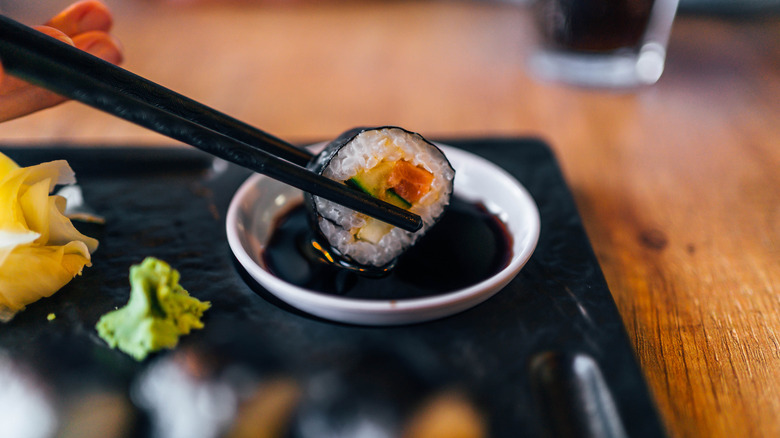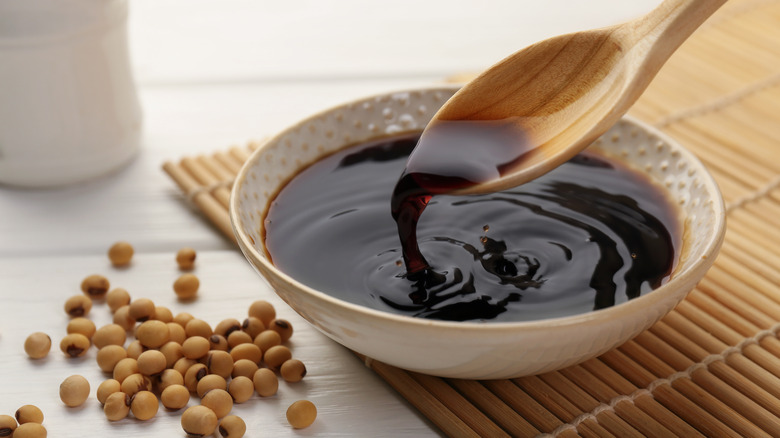What's The Difference Between Soy Sauce And Shoyu?
Soy sauce is a condiment that needs no introduction. The delicious and versatile sauce that's brimming with umami has its ancient origins in the Western Han Dynasty over 2,000 years ago. Today, it has outgrown its Chinese origins and taken the entire world by storm, becoming a true kitchen essential. Whilst "soy sauce" is a term that refers to all kinds of soy sauce, there are many regional variations of soy sauce across Asia which have developed a unique identity of their own. While many people are not aware of these distinctions, several of these regional sauces, including Japanese soy sauce (known as shoyu), are in fact very different to classic soy sauce.
Soy sauce was introduced to Japan from China, so, at the heart of it, shoyu and traditional Chinese soy sauce have the same roots. Since then, however, the Japanese have given shoyu an identity that truly sets it apart. Whilst classic soy sauce and shoyu are both made using fermented soybeans, these sauces differ in what other ingredients they are made of, what flavor profile they have, and what their consistency is like.
What is shoyu?
The key difference between soy sauce and shoyu is the ingredients. To ferment shoyu, four main ingredients are used: soybeans, wheat, salt, and water. The Japanese process involves mixing steamed soybeans, crushed roasted wheat, and saltwater with a fermenting agent (most commonly koji mold) to create a mixture called moromi. The moromi is left to ferment for up to a year. When it is finished fermenting, the liquid is placed into cloth bags and squeezed, extracting the raw soy sauce. This liquid is then pasteurized. The final product tastes different to Chinese soy sauce thanks to the wheat which gives it a slightly cleaner, sweeter flavor. (Wheat and soybeans are often used on a 1:1 ratio when making shoyu.)
Shoyu is generally lighter and milder than Chinese soy sauce due to the inclusion of wheat, but its long and evolving history has seen it develop a wide array of different flavors. Although some people only distinguish between light and dark shoyu, there are many unique variations, including koikuchi, usukuchi, saishikomi, and shiro. Koikuchi is an all-purpose dark soy sauce that accounts for about 80% of soy sauce production in Japan. It offers a great balance of salty and savory flavors. Usukuchi is a lighter option but has a noticeably more savory taste. Shiro is very light, using mostly wheat in the fermentation process. Finally, saishikomi is double fermented, resulting in a strong and fragrant sauce. Tamari, which is very different to soy sauce is a wheat-free sauce that is a by-product of miso production. While not technically a type of shoyu, it is often associated with this family of sauces.
What is soy sauce?
When making shoyu, wheat is one of the key ingredients. However, when making classic Chinese soy sauce, wheat is usually entirely absent from the fermentation process. (If wheat is used, it is usually only in very small amounts.) Instead, the key ingredients in traditional Chinese soy sauce are just soybeans, salt, and water. As with shoyu, traditional Chinese soy sauce takes months to fully ferment and is inoculated with a strain of mold.
Thanks to the industrialization of the soy sauce production process (which is needed to meet the vastly increased demand both in China and worldwide), it's also common practice for commercial soy sauce brands to chemically produce their products using a number of additional ingredients. These sauces are often ready in a handful of days and use food colorings and sugars to add color and flavor.
Chinese soy sauce comes in three prominent variations: regular, light, and dark. Light soy sauce is the thinner, saltier option. (This soy sauce is saltier than most types of shoyu.) It works as an ideal seasoning. Dark soy sauce is a less salty but more viscous sauce; it is generally thicker than most types of shoyu. Dark soy sauce is used to add a rich, deep brown hue to dishes and is often used in braises. Regular soy sauce is the middle ground between these two and is highly versatile.



